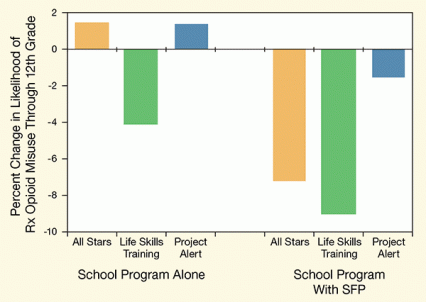
The Life Skills Training (LST) prevention intervention, delivered in 7th grade classrooms, helps children avoid misusing prescription opioids throughout their teen years, NIDA-supported researchers report. Coupling LST with the Strengthening Families Program: for Parents and Youth 10–14 (SFP) enhances this protection.
Dr. D. Max Crowley from Duke University, with colleagues from Pennsylvania State University, evaluated the impacts of LST and two other school-based interventions, All Stars (AS) and Project Alert (PA), on teens’ prescription opioid misuse. The researchers drew the data for the evaluation from a recent trial of the PROmoting School-community-university Partnerships to Enhance Resilience (PROSPER) prevention program. PROSPER is led jointly by Richard Spoth at Iowa State University and Mark Greenberg at Penn State University, with research funding from NIDA.
The new evaluation also disclosed that communities that implemented LST in the PROSPER trial more than recouped its cost in reduced health, social, and other expenditures related to teen prescription opioid misuse. The researchers recommend that communities consider implementing LST plus SFP to help control the ongoing epidemic of youth prescription opioid misuse. LST was the only intervention of the three tested that was effective by itself, and it was the most effective when the interventions were combined with SFP.
Lessons That Stick
In the PROSPER trial, 14 communities in Iowa and Pennsylvania each selected, from among LST, AS, and PA, the intervention they felt best fit their resources and their youths’ risk profile for drug use and other unhealthy and delinquent behaviors. The interventions are all “universal,” meaning that they are delivered to all children, not just those who are judged to have elevated risk for problems.
All the interventions involve multiple sessions of classroom instruction addressing the social and psychological factors that lead to experimentation with drugs and other undesirable behaviors. In addition, through games, discussion, role-playing, and other exercises, students practice refusing drugs, communicating with peers and adults, making choices in problem situations, and confronting peer pressure. The programs’ curricula focus on helping students to develop practical skills they can apply to resist drug use. Materials such as worksheets, online content, posters, and videos augment all three programs.
Each intervention was delivered to all 7th graders in the schools of the PROSPER communities that selected it. Most of the children and their families also received the SFP program during the prior year, when the children were in 6th grade. In SFP, families gather together to watch videos providing advice and instruction toward enhancing family relationships and communication, fostering parenting skills, improving academic performance, and preventing risky behaviors. Group leaders then conduct follow-up lessons and practice exercises.
Dr. Crowley and colleagues previously reported that smaller percentages of children from the 14 PROSPER communities reported illicit drug use and problematic alcohol use in annual follow-up visits conducted through 11th grade, compared to children from 14 matched control communities that did not use any evidence-based prevention program. As well, fewer PROSPER children reported marijuana use in 12th grade.
In their new analysis, the researchers isolated the effects of the three interventions on misuse of prescription opioids. Their analysis showed that LST-only recipients were less likely to report ever having misused these medications than were children in control communities, throughout middle and high school. The prevalence advantage with LST reached 20.2 percent versus 25.9 percent in 12th grade. Pairing LST with SFP increased the advantage to 16.3 percent versus 25.9 percent in 12th grade (see Figure).
SFP followed by AS helped recipients avoid prescription opioid misuse. However, this combination was less effective than LST plus SFP, resulting in a prevalence advantage, versus control, of 19.6 percent versus 25.9 percent in 12th grade. PA did not significantly reduce misuse of the drugs either alone or in combination with SFP.
 Figure. Evidence-Based Prevention Programs for 7th Graders Lower Risk for Prescription Opioid Misuse Before 12th Grade Researchers calculated that participating in Life Skills Training (LST) in 7th grade reduced a child’s likelihood of initiating prescription opioid misuse before 12th grade by 4.4 percent. Of the 6 prevention approaches used in the PROSPER study, LST plus Strengthening Families: for Parents and Youth 10−14 (SFP) reduced children’s risk of prescription opioid misuse the most.
Figure. Evidence-Based Prevention Programs for 7th Graders Lower Risk for Prescription Opioid Misuse Before 12th Grade Researchers calculated that participating in Life Skills Training (LST) in 7th grade reduced a child’s likelihood of initiating prescription opioid misuse before 12th grade by 4.4 percent. Of the 6 prevention approaches used in the PROSPER study, LST plus Strengthening Families: for Parents and Youth 10−14 (SFP) reduced children’s risk of prescription opioid misuse the most.
- Text Description of Graphic
-
The figure shows a bar graph indicating the change in likelihood of prescription opioid misuse among teens in grade 12 for three school programs alone and in combination with the SFP 10-14 program. The vertical (y)-axis shows the percent change in the likelihood of prescription opioid misuse and the horizontal (x)-axis the three programs, All Stars, Life Skills Training, and Project Alert, alone and in combination with SFP 10-14. When used alone, All Stars led to an increase of just under 2 percent, Life Skills Training to a decrease of about 4 percent, and Project Alert to an increase of just under 2 percent in the likelihood of prescription opioid misuse among 12th graders. When used in combination with SFP 10-14, All Stars led to a decrease of about 7 percent, Life Skills Training to a decrease of about 9 percent, and Project Alert to a decrease of just under 2 percent in the likelihood of prescription opioid misuse among 12th graders.
Win-Win
Dr. Crowley and colleagues determined that LST’s impact on teens’ prescription opioid misuse made it a good financial, as well as health, investment for PROSPER communities. They reached this conclusion by:
- Estimating the cost to prevent each case of prescription opioid misuse (by dividing the total cost of LST materials, training, etc., by the number of cases prevented).
- Comparing that number to $7,500, which they estimated, based on previously established figures, is the average expenditure incurred by communities for each single case of teen prescription opioid misuse.
These calculations indicated that PROSPER communities that implemented LST laid out $613 and saved $6,887 for each child that the program prevented from misusing prescription opioids. The corresponding estimates for LST plus SFP indicated expenditures of $3,959 and savings of $3,541 per case averted. Even though communities saved less per benefited child with LST alone, the researchers note, their health benefits were greater and their total savings may have been greater with LST plus SFP, because more cases were prevented.
Numerous studies have shown that LST shields children against other substance use and problem behaviors in addition to LST (see LST’s Broader Impact on Substance Use). These benefits presumably would further increase communities’ economic advantage in implementing the program.
Dr. Crowley says, “This work illustrates that not only can existing universal prevention programs effectively prevent prescription drug misuse, they can also do so in a cost-effective manner. Our research demonstrates the unique opportunities to combine prevention across school and family settings to augment the larger prevention impact.”
LST’s Broader Impact on Substance Use
A study by researchers from Iowa State University led by Dr. Richard Spoth yielded results consistent with those of Dr. Crowley’s team, providing further support for LST as an effective tool for preventing substance use among youth. Dr. Spoth and colleagues randomized students from 36 Iowa schools into three experimental groups: LST alone, LST plus SFP, and a control group. Dr. Spoth’s team periodically collected questionnaire data from the study participants from 7th grade through age 22.
The researchers’ findings revealed significant effects of LST on outcomes when the students reached young adulthood, including fewer alcohol-related problems and lower cigarette and substance use. LST’s effects were more pronounced for those youth who were at higher risk for substance use. In light of these results, Dr. Spoth and colleagues conclude that LST may delay initiation of substance use and thereby decrease substance use and related problems in early adulthood.
The studies were supported by NIH grants DA034501, DA013709, DA010075, DA17629, and DA10815.
Sources:
Crowley, D.M.; Jones, D.E.; Coffman, D.L.; Greenberg, M.T. Can we build an efficient response to the prescription drug misuse epidemic? Assessing the cost effectiveness of universal prevention in the PROSPER trial. Preventive Medicine 62:71-77, 2014. Full text
Spoth, R.; Trudeau, L.; Redmond, C.; Shin, C. Replication RCT of early universal prevention effects on young adult substance misuse. Journal of Consulting and Clinical Psychology 82(6):949-963, 2014. Abstract
